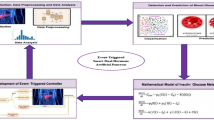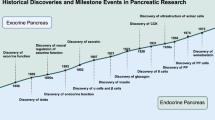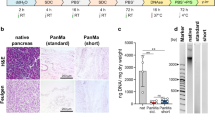Abstract
IT has been suggested that the hyperglycæmic substance present in the blood of the pancreaticoduodenal vein of animals treated with the growth hormone of the pituitary gland is 5-hydroxytryptamine1. This amine may be derived from the enterochromaffin or other cells of the gastrointestinal tract. Yet injections of 5-hydroxytryptamine into normal dogs fail to produce a significant rise in blood sugar, although similar injections into depancreatized animals result in hyperglycæmia. Thus the pancreas may be responsible for the inactivation of 5-hydroxytryptamine.
This is a preview of subscription content, access via your institution
Access options
Subscribe to this journal
Receive 51 print issues and online access
$199.00 per year
only $3.90 per issue
Buy this article
- Purchase on SpringerLink
- Instant access to full article PDF
Prices may be subject to local taxes which are calculated during checkout
Similar content being viewed by others
References
Sirek, A., Nature, 179, 376 (1955).
Gaddum, J. H., and Giarman, N. J., Brit. J. Pharmacol., 11, 88 (1956).
Author information
Authors and Affiliations
Rights and permissions
About this article
Cite this article
WEST, G. 5-Hydroxytryptamine and Hyperglycæmia. Nature 182, 182 (1958). https://doi.org/10.1038/182182a0
Issue date:
DOI: https://doi.org/10.1038/182182a0
This article is cited by
-
Uptake of DOPA and 5-HTP in pancreatic islets and parafollicular cells studied by combined autoradiographic and fluorescence microscopic techniques
Zeitschrift f�r Zellforschung und Mikroskopische Anatomie (1971)
-
Serotonin and insulin release in vitro
Diabetologia (1968)
-
Die Beeinflussung der Mitoserate des Ehrlich-Ascites-Carcinoms der weißen Maus durch Serotonin
Zeitschrift für Die Gesamte Experimentelle Medizin (1965)
-
Hyperglycæmia induced in Rabbits by 5-Hydroxytryptophan
Nature (1958)



